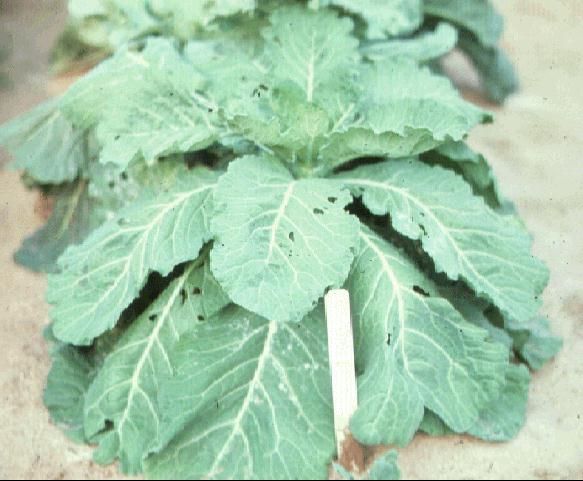Collards—Brassica oleracea L. (Acephala group)1
The collard is a green, leafy vegetable whose nutritious cabbage-like leaves are cooked as greens (often called soul food). It has been a mainstay in home gardens all over Florida and other southern states for many years. As a commercial crop, collards have provided fair net returns for small-acreage farmers selling locally and to processing companies.
Description
The edible portions of the collard plant are the dark green leaves borne in a rosette fashion around an upright, stocky main stem. The long-stemmed leaves resemble cabbage leaves, except that they are oval in shape instead of round. Collards are similar to kale in many respects, but differ mainly in leaf shape and flavor. These two leafy types of nonheading cabbages bear the same Latin name. The name Acephala means "without a head." Collard is a corruption of coleworts or colewyrts, Anglo-Saxon terms meaning "cabbage plants." The collard plant has changed little in form for at least 2,000 years, according to botanical historians.

Credit: James M. Stephens
Culture
The collard plant is a biennial, which means it sends up a flower stalk in the second season of its growth. In Florida, the collard thrives over a wide range of growing conditions and is grown throughout most of the year. However, the quality and taste are better and the plant grows best during the cooler months of the year. The best quality collards are those planted in the fall and harvested during light frost periods of early winter. The plant can withstand exposure to temperatures as low as 15°F, unless such a freeze abruptly follows a warm period of growth. Continued exposure to relatively low temperatures for extended periods of time may cause collards to produce seedstalks. This tendency to bolt varies with the size of the plant, temperature, and length of exposure. For example, it usually requires less cold exposure for older plants to go to seed (bolt) than for younger plants. The variety 'Vates' is more resistant to bolting and leaf damage during cold weather than 'Georgia.' The standard, old-time favorite collard variety is 'Georgia' (also known as 'Southern'). There are several strains of the 'Georgia' variety. 'Georgia' is characterized by its smooth leaves and whitish stems. The main stem of the plant averages around 3 feet tall, but may exceed 6 feet. The other standard variety is 'Vates,' which has wavy leaves. Other varieties recommended for Florida are 'Hicrop,' 'Heavicrop,' and 'Blue Max,' which are very uniform hybrids. 'Morris Heading' is a type that grows upright for 2 or 3 feet then forms a loose, cabbage-like head.
Collards may be seeded directly in the garden row, but best results are obtained by setting transplants. Rows should be spaced 24 to 36 inches apart, and plants 6 to 18 inches.
Collards respond very well to fertile soil conditions. Liberal amounts of composted plant or animal manure worked into each row 2 or 3 weeks before planting will greatly benefit collards.
The most troublesome pest on collards is the cabbage looper that chews large and small holes in the leaves. Other caterpillars, such as the imported cabbage worm, are bothersome also. Major diseases are black rot, downy mildew, and alternaria leaf spot. Damp-off disease and nematode problems are best controlled by soil fumigation prior to planting.
Harvesting and Use
Collards require 6 to 8 weeks after planting before they are ready for harvest. There are two common ways to harvest collards. Either the leaves are cropped, leaving the bud to grow new leaves, or the entire plant is harvested at one cutting.
The freshly harvested leaves should be washed, cooled immediately to 34–40°F, and stored in the refrigerator crisper until used. Like other cooking greens such as turnips and mustards, collard leaves are cut into thin, chewable pieces and then pot-boiled along with meat or other seasoning until tender.


